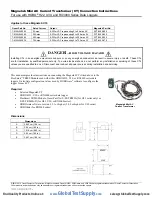
APPENDIX A: SPECIFICATIONS
A-2
FOT-F3 USER’S MANUAL
Parameter
Typical
Minimum
Maximum
Receive
Sensitivity:
-31.0 dBm
-36.0 dBm
-30.0 dBm
Max. Receive
Input Power:
—
—
-14.0 dBm
Transmitter Power
at 25
°
C Into
8.3/125
µ
m fiber:
-18.0 dBm
-21.0 dBm
-15.0 dBm
Output Power
Coefficient:
-0.07 dB/
°
C
—
—
Notes:
Transmitter Power decreases as temperatures rise and increases as
temperatures fall. Use the Output Power Coefficient to calculate
increased or decreased power output for your operating
environment. For example, the typical power output at 25
°
C is
-16.4 dBm. For a 4
°
C temperature increase, multiply the typical
coefficient (-0.07 dB) by four and add the result to typical output
power: (4
°
C x -0.07 dB/
°
C
) + -16.4 dBm = -16.7 dBm).
The transmitter power levels and receive sensitivity levels given
above are Peak Power Levels after optical overshoot. You must use
a Peak Power Meter to correctly compare the values given above to
those measured on any particular port.
If you are measuring power levels with an Average Power Meter,
add 3 dBm to the measurement to correctly compare those
measured values to the values listed above
(i.e., -30.5 dBm peak = -33.5 dBm average).
Table A-1 Fiber Optic Interface Specifications (Continued)



































